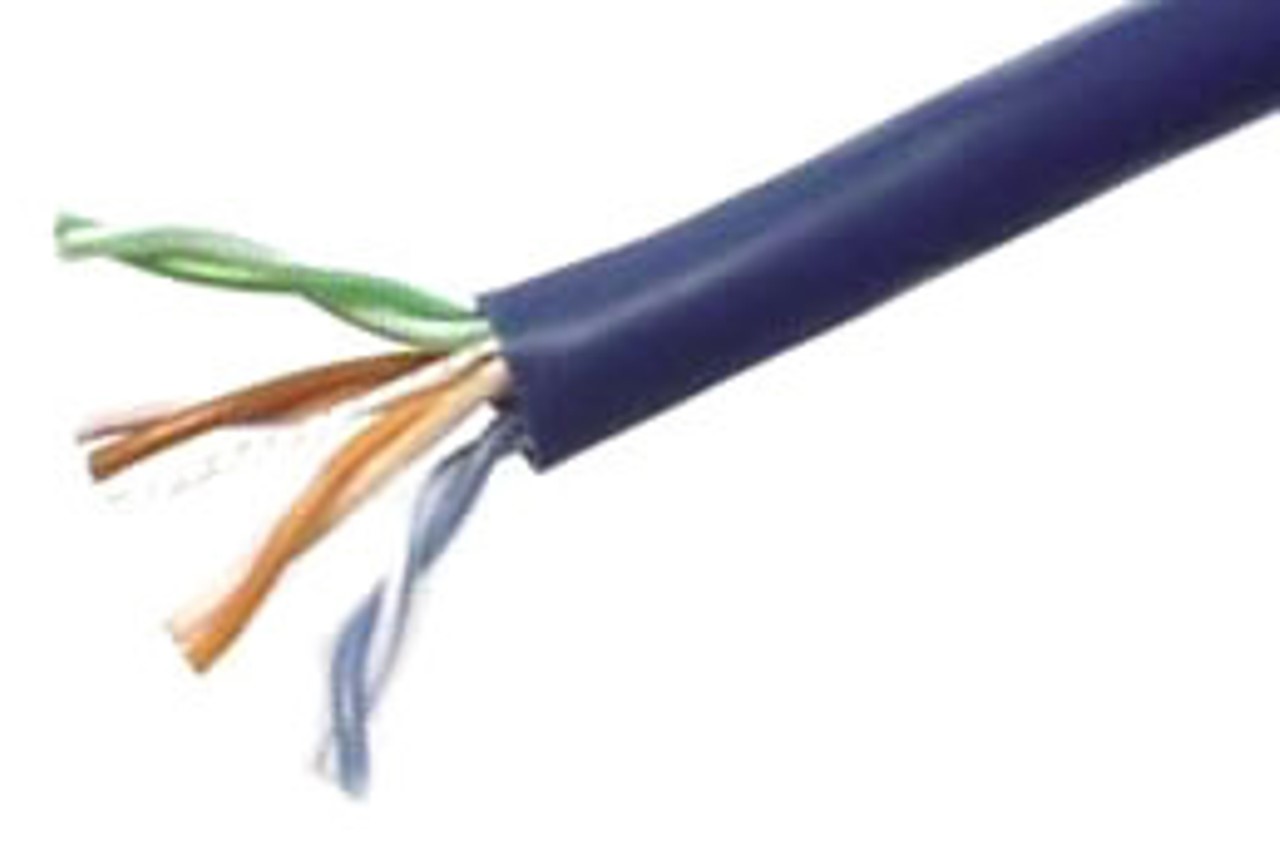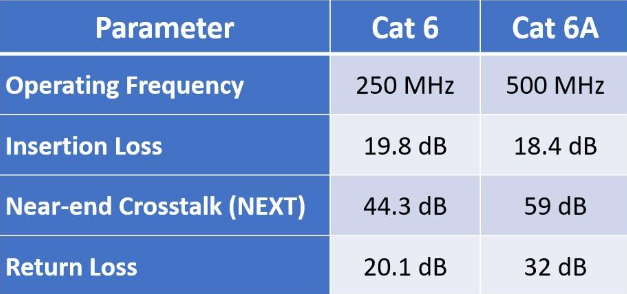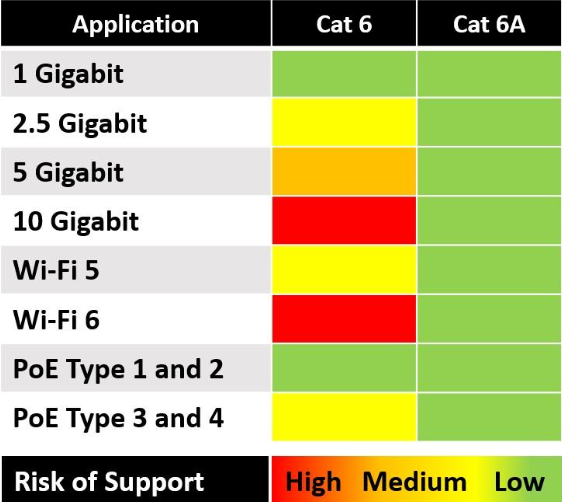
Everyone knows that Category 6A twisted-pair cabling offers augmented performance over Category 6—hence the "A" for augmented. But understanding technically how Cat 6A compares to Cat 6 can help you determine which is best for your specific application needs and budget.
Cat 6 Cabling
![]()
Cat 6 cabling was ratified by TIA industry standards in 2002, just a year after Cat 5e. At that time, Cat 5e, with an operating frequency of 100 MHz, supported Gigabit transmission speeds (i.e., 1000 Megabits per second) to 100 meters. Cat 6 cabling raised the operating frequency to 250 MHz but was still only slated to support Gigabit speeds. So why exactly was it introduced if it supported the same transmission speed? That's a good question—especially since it was about 50% more expensive than Cat 5e when it first hit the market.
While both Cat 6 and Cat 5e could handle Gigabit speeds, Cat 5e cables offered very little (if any) headroom. In noisy environments that introduce crosstalk interference or where the cables need to carry more data, network operators struggled with the limited performance of Cat 5e and associated higher bit error rates. Cat 6's higher bandwidth capability and plastic spline to separate the pairs for improved internal crosstalk eliminated the problems. In addition, Cat 6's slightly larger gauge size of 23 AWG compared to 24 AWG for Cat 5e handled heat build-up better for power over Ethernet (PoE) applications that were becoming more commonplace at the time with the introduction of IEEE 802.3af Type 1 PoE that delivers up to 15 Watts (W) of power and IEEE 802.3at Type 2 PoE that delivers up to 30W. Over the years, the price differential dropped considerably. Cat 6 today typically costs only 10% to 15% more than Cat 5e.
Cat 6A Cabling

Ratified by industry standards in 2009, Cat 6A "augmented" the performance of twisted-pair cabling to deliver double the bandwidth, operating at a frequency of 500 MHz to support 10 Gigabit transmission speeds to 100 meters. To achieve this performance, Cat 6A is more precisely manufactured with tighter tolerances and twist rates to meet more stringent cable specifications. As shown below, insertion loss is 7% better, near-end crosstalk is 25% better, and return loss is 37% for Cat 6A compared to Cat 6.

While Cat 6A cables are 23 AWG like Cat 6, tighter pair twist, a larger spline, and thicker insulation and jacketing material resulted in increased diameter for Cat 6A—some early Cat 6A cables were as large as 0.35" compared to just 0.24" for Cat 6. These larger diameters required more pathway space and a more complicated installation process. However, since its introduction, cable manufacturers have been able to reduce the diameter of Cat 6A closer to that of Cat 6 without impacting performance. The cost differential has also dropped, with Cat 6A typically only running about 20% more than Cat 6.
Cat 6 vs. Cat 6A - Which Do You Need?
Choosing between Cat 6 and Cat 6A depends on which applications you need to support. Some installed Cat 6 cables may support 10 Gigabit to distances of 35 to 55 meters, but you'll need to conduct qualification testing to verify support. Cat 6, and even some Cat 5e cables, can also support 2.5 and/or 5 Gig speeds to 100 meters, which is required for Wi-Fi 5 deployments. But again, qualification testing is needed to verify support.
Conversely, Cat 6A supports all speeds up to 10 Gigabit to 100 meters. In addition, the improved insertion loss performance of Cat 6A provides superior support for 802.3bt Type 3 PoE that delivers up to 60W of power and Type 4 PoE that delivers up to 90W. Because insertion loss increases with heat and distance, using Cat 6 for higher levels of PoE may require shorter link lengths, even if the link only needs to support Gigabit speeds.
In short, Cat 6A is considered the most future-proof type of twisted-pair cabling and is recommended by industry standards for all new deployments, providing peace of mind for supporting the latest LAN applications. If you're working on a very tight budget and only need to support Gigabit speeds and lower levels PoE, with no plans to deploy more advanced applications, Cat 6 is certainly an option. However, as shown in the table below, the slight cost increase for Cat 6A is well worth eliminating the risk of not adequately supporting today's applications and facing the potential expense and disruption of having to replace Cat 6.

The good news is that Cables Plus USA offers a one-stop shop for all your copper cabling needs. If you're still unsure whether or not you need Cat 6 or Cat 6A for your applications, our experts are always here to help you choose the best option. Contact us, and we will be happy to assist you!

